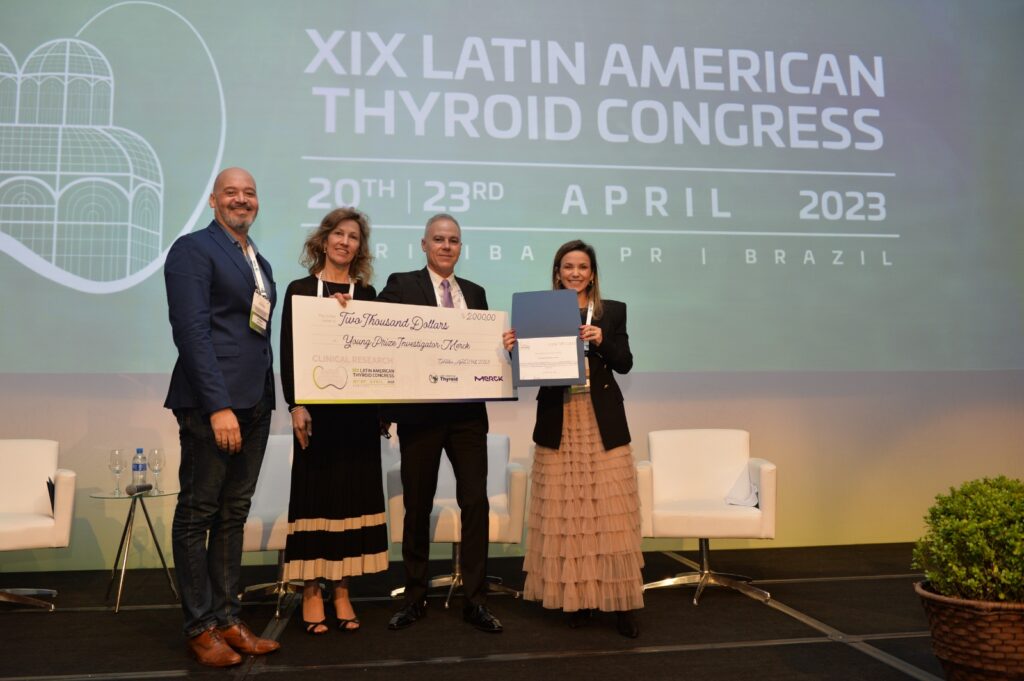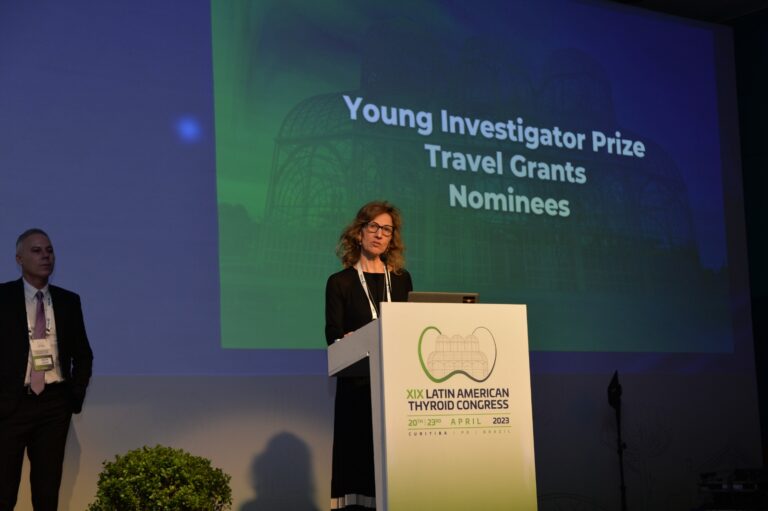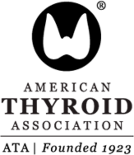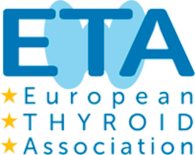The LATS 2023 Congress had two moments for the awards. An award from the Society and another for scientific works.
The first took place at the opening of the event, with the delivery of the Lats Senior Prize 2023 to Dr. Claudia Gabriela Pellizas (Argentina). The presentation was made by Dr. Fabian Pitoia (Argentina), President of Lats 2023; and Dr. Ana Maria Masini-repiso (Argentina)
The Conference of Dr. Claudia was “my journey across thyroid hormone action: focus on immunity”.
LATS Young Investigator Award
In the last session, the LATS organization released the awards for young investigators.


Awarded:
Oral Presentation – LATS Young Investigator Award 2023 – Clinical – Clinical / Thyroid and Metabolism
– CARDIOMETABOLIC RISK AND INSULIN RESISTANCE IN PATIENTS WITH RESISTANCE TO THYROID HORMONE Β
Presenter: Pryscilla Moreira de Souza Domingues Hajj
Oral Presentation – Basic – Basic / Thyroid Cancer Basic
– INHIBITION OF EZH2 METHYLTRANSFERASE ACTIVITY INDUCES AN ANTITUMORAL EFFECT AND IMPROVES CELL DIFFERENTIATION IN ANAPLASTIC THYROID CANCER
Presenter: Diego Claro de Mello
Abstratcs:
– CARDIOMETABOLIC RISK AND INSULIN RESISTANCE IN PATIENTS WITH RESISTANCE TO THYROID HORMONE Β
Presenter: Pryscilla Moreira de Souza Domingues Hajj
Abstract: Introduction: In Resistance to Thyroid Hormone due mutations in thyroid hormone receptor β (RTHβ), the peripheral tissues show variable refractoriness to the action of thyroid hormones (TH). The effect of TH on insulin sensitivity differs by tissue – it enhances glucose uptake in the muscle but reduces it in the liver. The overall net effect in hypothyroidism favors insulin resistance Objectives: To assess cardiometabolic risks and insulin sensitivity in RTHβ patients. Methods: 16 patients (8 adults and 8 children/teenagers) with RTHβ and 29 healthy individuals (15 adults and 14 children/teenagers), matched for sex, age, and body mass index (BMI), were evaluated with anthropometric measurements and with dosages of glycemia, lipids, insulin, interleukin-6 (IL-6), TNF-alpha, leptin and adiponectin, ultrasensitive c-reactive protein. Fat percentiles and lean mass were also evaluated using the Bioimpedance technique (BIA) and the trunk and peripheral fat percentiles using the dual emission X-ray absorptiometry technique (DXA). Insulin sensitivity was performed in adult patients and controls with the Hyperinsulinemic Euglycemic Clamp (CEH); HOMA-IR was calculated in all individuals studied. Results: the mean ages (in years) of adult patients and controls and affected children/teenagers and controls were, respectively, 52.3 ± 16.3 vs 48.5 ± 16.6 (P=0.5), and 10.88 ± 3.94 vs 10.00 ± 3.08 (P=0.4). By univariate analysis, there was no difference between waist-hip and waist-height ratio in both adult and children/teenagers groups. RTHβ patients exhibited higher cholesterol (P=0,04) and LDL than controls (P= 0.03) but no difference in triglycerides levels. A significant difference was observed in IL-6 levels between RTHβ patients and controls (P<0.01). There was no evidence of insulin resistance evaluated by CEH and HOMA-IR. Conclusion: We did not demonstrate insulin resistance in patients with RTHβ studied, using the gold standard method, the hyperinsulinemic-euglycemic clamp. However, higher levels of total cholesterol and LDL-cholesterol were found in adults patients, which implies the need for controlled and continuous patient monitoring to prevent increased cardiometabolic risks in this disease. We demonstrated for the first time the increase in IL-6 levels in patients with RTHβ, as occurs in autoimmune thyroid diseases and goiter. A larger number of patients should be studied to confirm these results.
Authors: PRYSCILLA MOREIRA DE SOUZA DOMINGUES HAJJ / Domingues-Hajj PMS / Ribeirão Preto Medical School -USP; Patrícia Moreira Gomes / Gomes PM / Ribeirão Preto Medical School -USP; Patricia Künzle Ribeiro Magalhães / Magalhães PKR / Ribeirão Preto Medical School -USP; Léa Maria Zanini Maciel / Maciel LMZ / Ribeirão Preto Medical School -USP;
– INHIBITION OF EZH2 METHYLTRANSFERASE ACTIVITY INDUCES AN ANTITUMORAL EFFECT AND IMPROVES CELL DIFFERENTIATION IN ANAPLASTIC THYROID CANCER
Presenter: Diego Claro de Mello
Abstract: Introduction: Anaplastic thyroid cancer (ATC) is an undifferentiated form of thyroid carcinoma that is lethal. Although ATC treatment has improved in the last years, the loss of differentiation and high rates of recurrence and metastasis remain as challenges to overcome. In the last decade epigenetic reprogramming has emerged as a new cancer hallmark and epigenetic alterations caused by upregulation of Polycomb Repressive Complex 2 (PRC2) may contribute to cancer aggressiveness by acting in gene silencing through histone modifications. EZH2 is the core catalytic component of PRC2 as its methyltransferase causes the trimethylation of H3 histone on lysine 27 (H3K27me3), a transcription repression mark. Thus, strategies to inhibit PRC2/EZH2 function by blocking EZH2 methyltransferase activity pharmacologically or permanently using CRISPR/Cas9-mediated gene editing may contribute to ATC’s treatment. Objectives: Investigate the role of PRC2/EZH2 in ATC’s biology and dedifferentiation. Methods: To permanently inhibit EZH2, we targeted the EZH2 gene with CRISPR/Cas9-mediated gene editing in ATC cell SW1736 and assessed cell function by in vitro and in vivo assays such as cell counting, migration, invasion, clonogenic assay and xenotransplant in nude mice (CEUA protocol 2023150720). Additionally, we treated ATC cells KTC2 and SW1736 with the EZH2 methyltransferase inhibitor EPZ6438 alone or in combination with the MAPK inhibitor U0126. Then, thyroid differentiation and EMT (epithelial-mesenchymal transition) genes expression were analyzed by qPCR and western blot and tumor features by immunohistochemistry. Results: CRISPR/Cas9-induced EZH2 gene editing in SW1736 cells reduced cell migration and invasion and reduced cell growth in vitro. Moreover, we observed upregulation of thyroid differentiation genes NIS, TG, TSHR and GLIS3 and induction of a mesenchymal-epithelial transition (MET), by increasing E-cadherin and miR-200a/c expression and reducing ZEB1/2 and N-cadherin levels, which contributed for transition to an epithelial-like cell morphology. In addition, EZH2-mediated gene editing also repressed Wnt/β-catenin signaling activation. In the xenograft study, SW1736 EZH2-edited cells formed tumors with reduced volume (~10% of control tumor volume) that showed less proliferation in the anti-Ki67 immunostaining and impairment of recruitment of cancer associated fibroblasts stained with anti-alpha-SMA antibody. Furthermore, pharmacological inhibition of EZH2 with EPZ6438 decreased colony formation and improved thyroid differentiation-genes expression in KTC2 and SW1736 cells, but the treatment with MAPK inhibitor U0126 did not enhance these effects. Conclusion: In this work, we show that EZH2 inhibition induces a strong antitumoral effect in vitro and in vivo by inducing MET and improving differentiation of thyroid follicular cells.
Authors: DIEGO CLARO DE MELLO / de Mello DC / Department of Cell and Developmental Biology. Institute of Biomedical Sciences, University of São Paulo.; Marcella Maringolo Cristovão / Cristovão MM / Department of Cell and Developmental Biology. Institute of Biomedical Sciences, University of São Paulo.; Kelly Cristina Saito / Saito KC / Department of Cell and Developmental Biology. Institute of Biomedical Sciences, University of São Paulo.; Edna Teruko Kimura / Kimura ET / Department of Cell and Developmental Biology. Institute of Biomedical Sciences, University of São Paulo.; Cesar Seigi Fuziwara / Fuziwara CS / Department of Cell and Developmental Biology. Institute of Biomedical Sciences, University of São Paulo.





